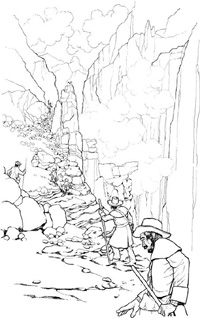Part 2: His Legacy  And ride down the river they did, braving some of the most dangerous water ever known. They lived to tell about it, including written and visual descriptions of what they saw. But what they didn't have was a map. Powell returned to his home state of Illinois and began traveling, giving speeches wherever he went, in an effort to raise money for another expedition. This one left in 1871 and produced a famous map. Now a national hero, Powell agreed to become the director of the U.S. Geological Survey, a post he held for 13 years. Through this post and writings and drawings that he and his expedition mates made, the settlement of the American West was made much easier and productive. Powell established a river gauge station along a broad but shallow stretch of the Rio Grande near Embudo, N.M., in 1889, the first of its kind in the nation. He also was the first to use what we consider common terms to describe what he saw out West: "runoff" and "acre-foot," among others. A champion of slow and patient settlement of the West (because of concerns over whether enough water could be found to accommodate the anticipated hoards of settlers), Powell became disillusioned with the American government's policy of rapid settlement and retired, in 1894. John Wesley Powell died in 1902, a legend in his own time and in ours. Books continue to be written and reports continue to be done about him. His concern for adequate water supply is now a reality, as western states jockey for control of water sources as more and more people move to the West. The story of the Grand Canyon can't be told without including the story of John Wesley Powell. |
|
Social Studies for Kids
copyright 2002–2025
David White


